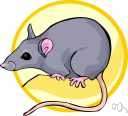1997: Distribution and breeding success of pallid swift, Apus pallidus, on Mediterranean island: nest predation by the
roof rat, Rattus rattus, and nest quality.
Her latest book, The Year a
Roof Rat Ate My Dishwasher: An Arizona Survival Guide for Entrepreneurs, is a humorous self-help tome for business people who live in, or are thinking of moving to, the fifth largest state in the U.S.
These include two primates (Himalayan rhesus monkey, hanuman grey langur); eight (8) Chiropetra (Indian false vampire bat, fulvous fruit bat, Himalayan pipistrelle, lesser horseshoe bat, common bent-wing bat, dark whiskered bat, Pallas's tube-nosed bat, Torresian tube-nosed bat or northern tube-nosed bat, Gilgit tube-nosed bat, and horseshoe bat); seven (7) carnivores (golden jackal, common leopard, Asiatic black bear, jungle cat, stoat or ermine, Himalayan palm civit and yellow-throated martin); and 12 rodents (Himalayan field mouse, house mouse,
roof rat or house rat, Eurasian pygmy shrew, Turkestan rat, Indian mole rat, short-tailed mole rat, small Kashmir flying squirrel, Royle's high mountain vole; and one artiodactyle (barking deer) species.
These include the Norway rat, the
Roof rat, the Wood rat (also known as pack rat, because of its propensity for collecting and storing items) and the Black rat.
Most rodents prefer fields to human habitats, but the opposite is true of three species uniquely adapted to living around humans: the house mouse, the
roof rat and the Norway rat.
The three rodents that have spread across the world are the common rat, found all over Britain, the house mouse and the black rat or
roof rat, which used to be the native species in Britain but is now almost extinct here.
Roof rat, black rat, house rat, ship rat (Rattus rattus)
The three main rodents your home buyers should worry about are the common rat, the
roof rat, and the house mouse.
If a
roof rat knocks on your door, call the police immediately and help prevent them conning other elderly victims.
For example, the potential for human plague cases in eastern Texas was demonstrated in 1993 when an infected
roof rat (Rattus rattus) and two infected fox squirrels (Sciurus niger) were identified in Dallas.
 roof rat - common household pest originally from Asia that has spread worldwide
roof rat - common household pest originally from Asia that has spread worldwide